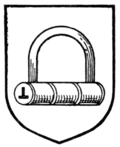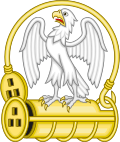Fetterlock
Fetterlock[edit]
The term "Fetterlock" refers to a specific type of lock or fastening mechanism that was commonly used in medieval times. It was primarily used to secure doors, gates, and other entrances, providing a reliable means of protection and security. The Fetterlock was a significant advancement in locking technology during its time and played a crucial role in fortifications and castles.
History[edit]
The Fetterlock originated in Europe during the Middle Ages and gained popularity as a reliable locking mechanism. It was typically made of iron or steel and consisted of two main components: a horizontal bar and a vertical bolt. The horizontal bar, known as the "fetter," was attached to the door or gate, while the vertical bolt, known as the "lock," was fixed to the door frame or wall.
The Fetterlock was designed to be operated from the inside, allowing occupants to secure themselves and their belongings. It provided a sturdy and effective means of protection against unauthorized entry, making it an essential feature in medieval fortifications.
Function[edit]
To operate a Fetterlock, one would insert the lock's bolt into the fetter, securing the door or gate in place. The bolt would slide into a slot or hole in the fetter, preventing the door from being opened from the outside. This mechanism ensured that only those with access to the inside could open the door or gate.
The Fetterlock's design made it difficult to tamper with or force open. Its sturdy construction and reliance on internal mechanisms made it resistant to external manipulation. This added an extra layer of security to medieval structures, making it challenging for potential intruders to breach the defenses.
Legacy[edit]
The Fetterlock played a significant role in medieval fortifications and castles, contributing to their overall security and defense. Its effectiveness as a locking mechanism ensured that only authorized individuals could gain access to protected areas. The Fetterlock's legacy can still be seen today in the architectural remnants of medieval structures.
See Also[edit]
References[edit]
<references />
-
Fetterlock
-
Falcon and Fetterlock Badge of Edward IV
Ad. Transform your life with W8MD's Budget GLP-1 injections from $75


W8MD offers a medical weight loss program to lose weight in Philadelphia. Our physician-supervised medical weight loss provides:
- Weight loss injections in NYC (generic and brand names):
- Zepbound / Mounjaro, Wegovy / Ozempic, Saxenda
- Most insurances accepted or discounted self-pay rates. We will obtain insurance prior authorizations if needed.
- Generic GLP1 weight loss injections from $75 for the starting dose.
- Also offer prescription weight loss medications including Phentermine, Qsymia, Diethylpropion, Contrave etc.
NYC weight loss doctor appointmentsNYC weight loss doctor appointments
Start your NYC weight loss journey today at our NYC medical weight loss and Philadelphia medical weight loss clinics.
- Call 718-946-5500 to lose weight in NYC or for medical weight loss in Philadelphia 215-676-2334.
- Tags:NYC medical weight loss, Philadelphia lose weight Zepbound NYC, Budget GLP1 weight loss injections, Wegovy Philadelphia, Wegovy NYC, Philadelphia medical weight loss, Brookly weight loss and Wegovy NYC
|
WikiMD's Wellness Encyclopedia |
| Let Food Be Thy Medicine Medicine Thy Food - Hippocrates |
Medical Disclaimer: WikiMD is not a substitute for professional medical advice. The information on WikiMD is provided as an information resource only, may be incorrect, outdated or misleading, and is not to be used or relied on for any diagnostic or treatment purposes. Please consult your health care provider before making any healthcare decisions or for guidance about a specific medical condition. WikiMD expressly disclaims responsibility, and shall have no liability, for any damages, loss, injury, or liability whatsoever suffered as a result of your reliance on the information contained in this site. By visiting this site you agree to the foregoing terms and conditions, which may from time to time be changed or supplemented by WikiMD. If you do not agree to the foregoing terms and conditions, you should not enter or use this site. See full disclaimer.
Credits:Most images are courtesy of Wikimedia commons, and templates, categories Wikipedia, licensed under CC BY SA or similar.
Translate this page: - East Asian
中文,
日本,
한국어,
South Asian
हिन्दी,
தமிழ்,
తెలుగు,
Urdu,
ಕನ್ನಡ,
Southeast Asian
Indonesian,
Vietnamese,
Thai,
မြန်မာဘာသာ,
বাংলা
European
español,
Deutsch,
français,
Greek,
português do Brasil,
polski,
română,
русский,
Nederlands,
norsk,
svenska,
suomi,
Italian
Middle Eastern & African
عربى,
Turkish,
Persian,
Hebrew,
Afrikaans,
isiZulu,
Kiswahili,
Other
Bulgarian,
Hungarian,
Czech,
Swedish,
മലയാളം,
मराठी,
ਪੰਜਾਬੀ,
ગુજરાતી,
Portuguese,
Ukrainian

